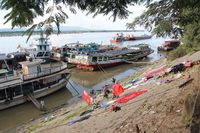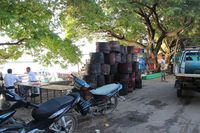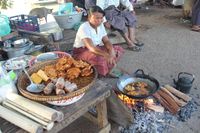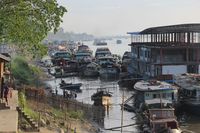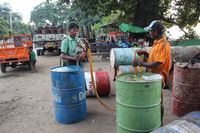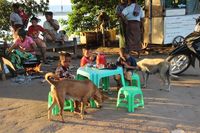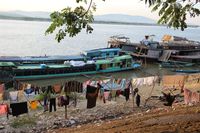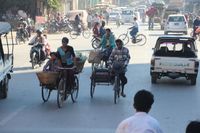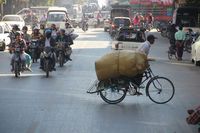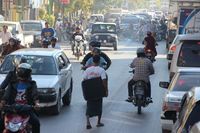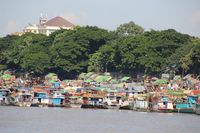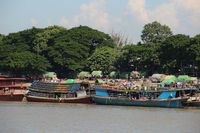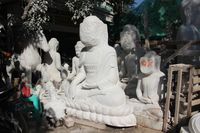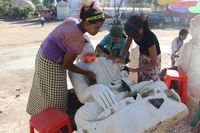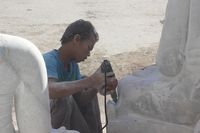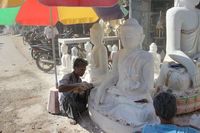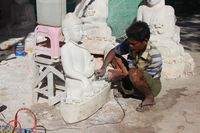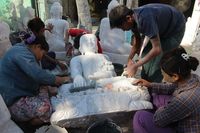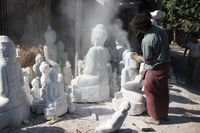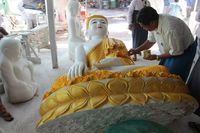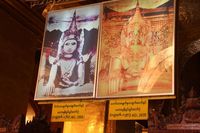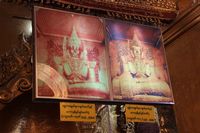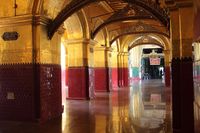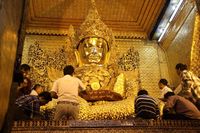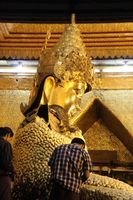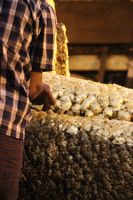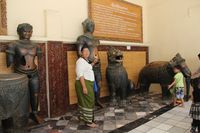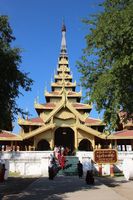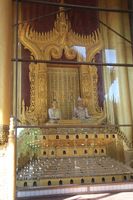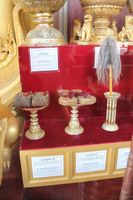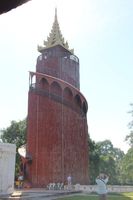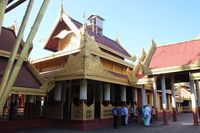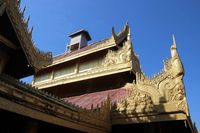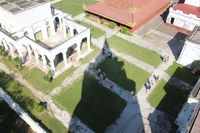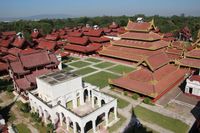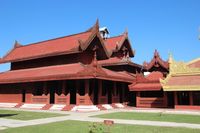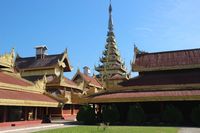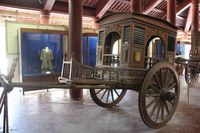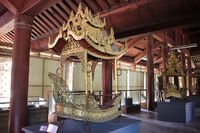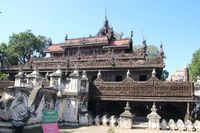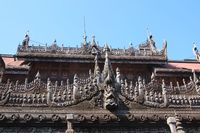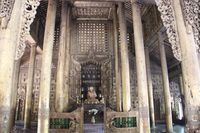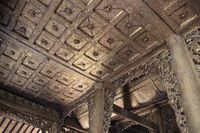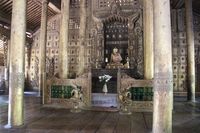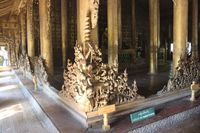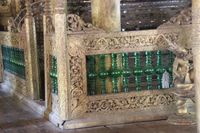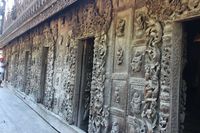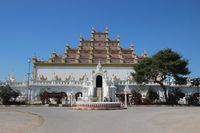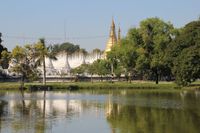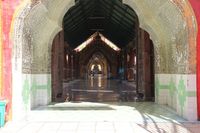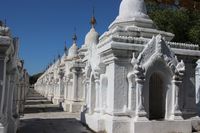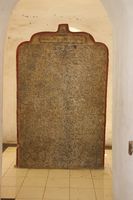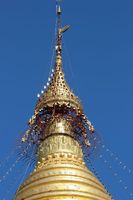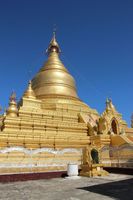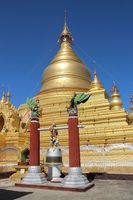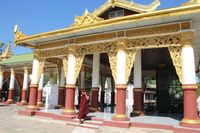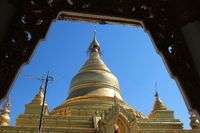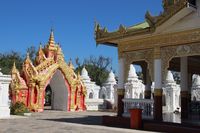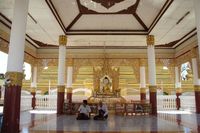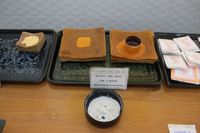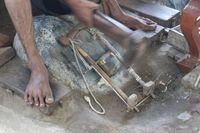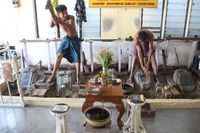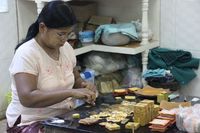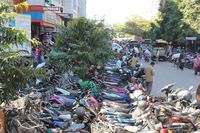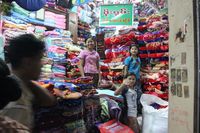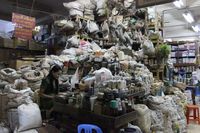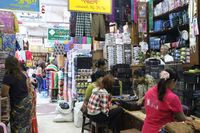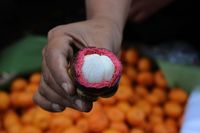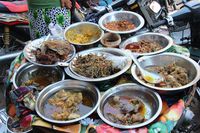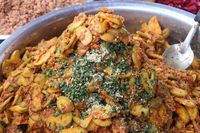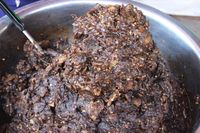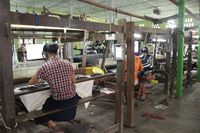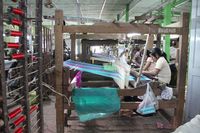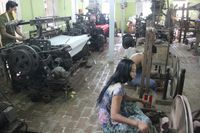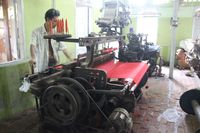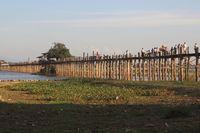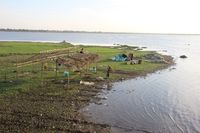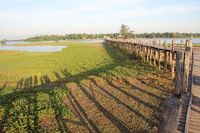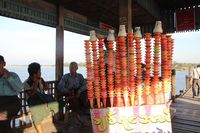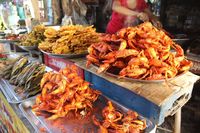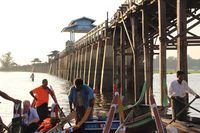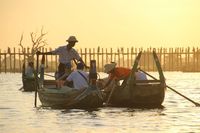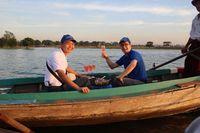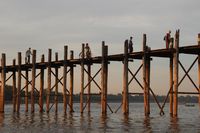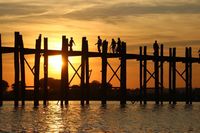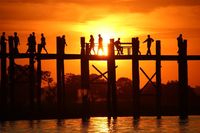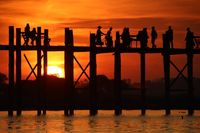Mandalay and Amarapura
Mandalay, the second largest city in Myanmar,
with a population of approx. 1.5m (of which
40% are Chinese origin), is a cultural, economic
and religious centre and was the last royal
capital of the country. Mandalay neighbours
the mountain regions of the Shan and Kachin
people and is their main market town in Upper
Burma.
Built between 1857 and 1859 under the order
of King Mindom, it fulfilled a prophecy (and
as is often the case with Monarchs, to his
own glory). The legend that Gautama Buddha
visited Mandalay Hill with his disciple Anana
and proclaimed that in 2400 years after his
death a great city for Buddhist teaching
will be founded at the foot of the hill.
Mahamuni Pagoda - the much admired Mahamuni Pagoda is one of
the three most visited religious sites in
Myanmar (the others being Shwedagon Pagoda
and The Rock). Its famous Buddha image is
covered with a thick layer of gold leaf placed
there over decades by visiting worshippers.
Ladies are not allowed to go near the Buddha.
Below you can see the Buddha as it was and
as it is today - much larger than the original.
Mandalay Palace
Mandalay was the site of a fierce battle
at the end of World War Two when the Grand
Palace/Fort Dufferin was bombed – it
has now been rebuilt but not on any standard
of its original glory. Although the buildings
are accurate copies, much of the detail is
missing. They have only been partly renovated.
Shwe Nan Daw / Kyaung Monastery
One of the most remarkable all-teak buildings
in Burma, the Shwenandaw Monastery was once
part of Mandalay’s enormous palace
complex of King Mindon. Its intricate carvings,
gilded columns and elaborate fretwork, give
a glimpse of the extravagant lifestyle once
enjoyed by Burmese royalty. The building
was dismantled and reassembled out of the
palace complex in 1880 which is the reason
that it is the only remaining existing building
of the royal palace. The other buildings
were lost to WWII bombs.
Kutodaw Pagoda
Built in 1857 by King Mindon as a copy of
the Shwezigon Pagoda in Bagan. Kutodaw often
called the 'world’s largest book',
consisting of 729 marble slabs inscribed
with Buddhist scriptures in triptaka text,
each within their own individual stupa.
Workshops and Market
We visited a street of Marble Carving Workshops where they carve the marble Buddhas. The
face is left until an order has been received
as there are many styles of face. Typically,
a 3ft high Buddha would cost about $2500.
Gold Leaf Workshop to see the gold leaf still beaten out by
hand. A tiny piece of gold is beaten for
30 minutes, then it is split into two and
beaten a second time for 30 minutes. Then
it is beaten for 5 hours to increase its
size.
ZeGyo Market. The main market bustles with life. The
warehouse is stacked high with textiles,
spices and household goods. Outside there
are fruit sellers and food vendors with an
array of offerings.
Amarapura
11 miles south of Mandalay, Amarapura means
‘City of Immortality’. It was
built by King Bodawpaya in 1762 and is the
youngest of the royal cities around Mandalay.
In its heyday it had 200,000 inhabitants
but it now has a population of only 35,000.
It is well known as a centre of weaving with
over 10,000 inhabitants producing some of
the finest festive clothing.
Weaving factory
We were greeted with the ‘click-clack’
sound from the looms of the cotton and silk
weavers, the small factory was filled with
hardworking people, both young and old.
U-Bein Bridge – the world’s longest teak bridge
The 1.2km teak bridge links Amarapura with
an island in the middle of Lake Taungthaman,
an intermittent body of water which dries
up during winter. It was built in 1849 from
old planks and timber posts salvaged from
the houses in Sagaing and Inwa (Ava). The
bridge has 1086 posts and 482 spans. At 9
points were draw bridges that would allow
boats to pass through towards the Irrawaddy.
As the river recedes in the dry season the
locals claim it for farming.
We walked across and then took a boat ride
back, stopping en route to see the sunset
set behind the bridge. We were treated to
a surprise glass of bubbly and a bowl of
nuts by our Cruise Manager. Very romantic
and very welcomed!
|
|
|
|
|
|
Royal Custom
It was the custom for every new King to move
the capital to a new site whenever he ascends
the throne and hence, there are many previous
capital cities in the Mandalay area. These
include Inwa (Ava), Amarapura and Mandalay. |
|
|
|
|
|
|
King Mindon thought he could achieve enlightenment
by making true the prophesy, so in 1861 he
disposed of his half-brother Pagan Min as
the Monbaung King. Taking over the throne,
he moved his capital – most of his
Palace as well as 150,000 of his subjects
– from Amarapura 20 km away. He built
the Royal Palace and worked towards realising
the ‘Golden City’ of Buddhist
teachings. Unfortunately, he died in 1878
and the tyrannic King Thibaw and his imperious
wife Supyalet took over the reign. During
their terror reign, they killed many of their
friends and relatives to prevent any challenge
to their rule. There was a smallpox epidemic
and on the advice of the astrologers, they
had many of their own subjects and foreigners
killed. This resulted in the invasion by
the British, who occupied upper Burma in
1885, when the palace became known as Fort
Dufferin.
|
|
|
|
|
|
The large bronze figures were brought to
Myanmar from Thailand by King Bayinaung Kyaw
- they originated from the Angkor Wat Temple
in Cambodia. They are called 'Devanat'
statures and the people believe that when
ever anyone suffers from pain and disease,
if they pray and brush the figures with the
related parts the pain and disease will be
relieved.
|
|
|
|
|
|
|












